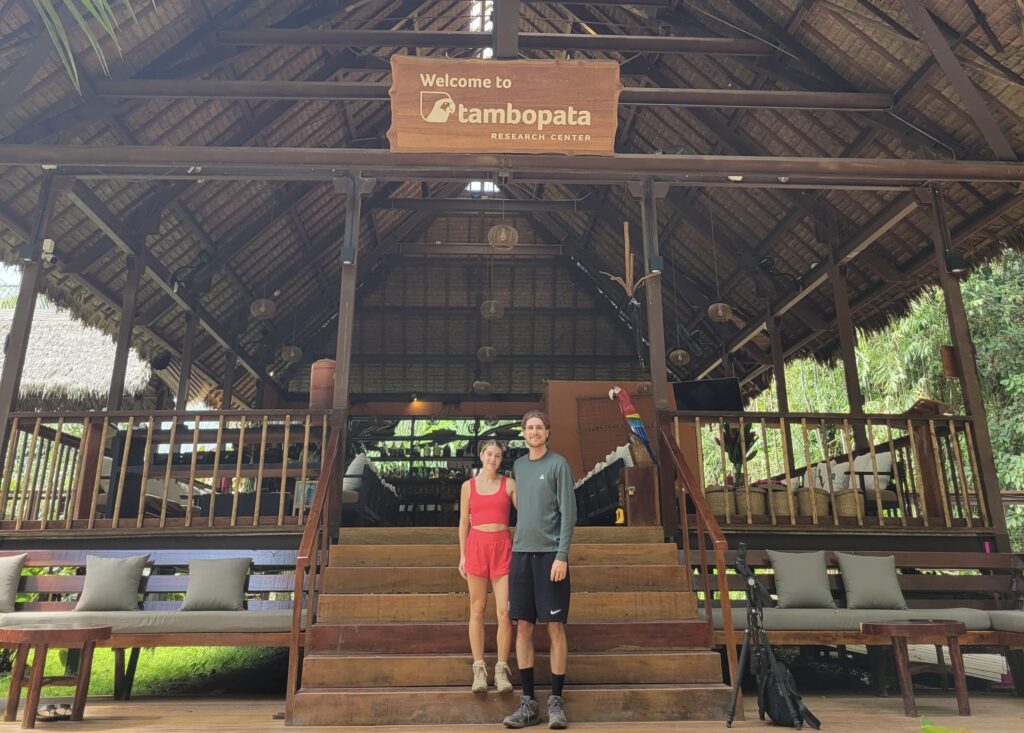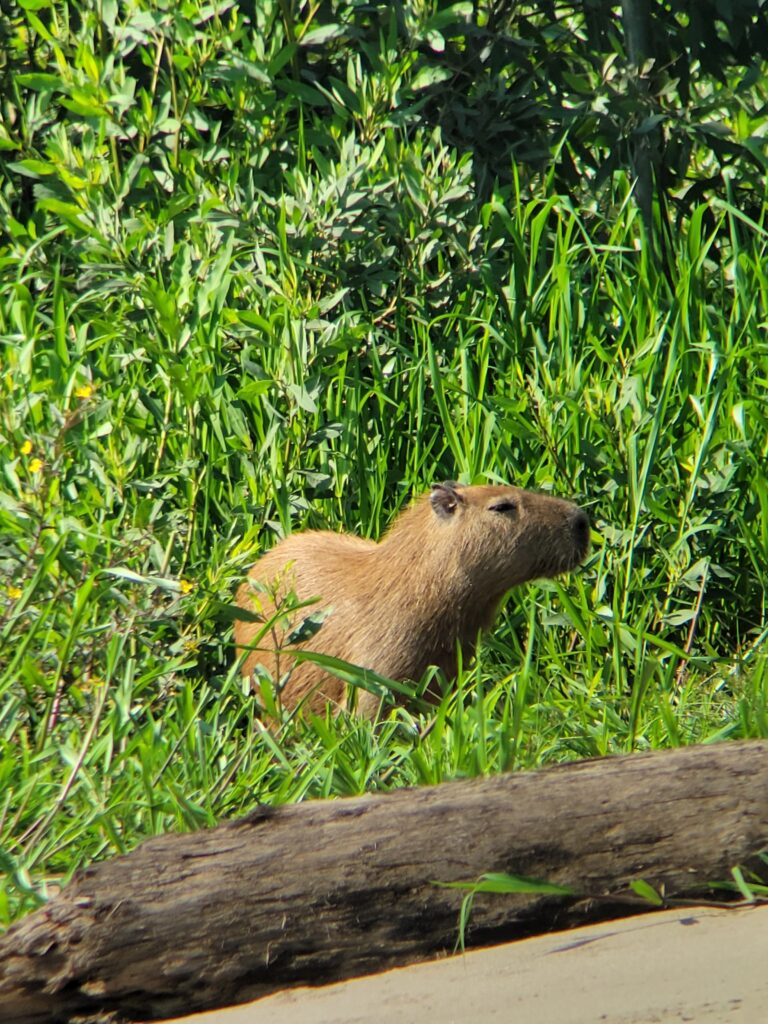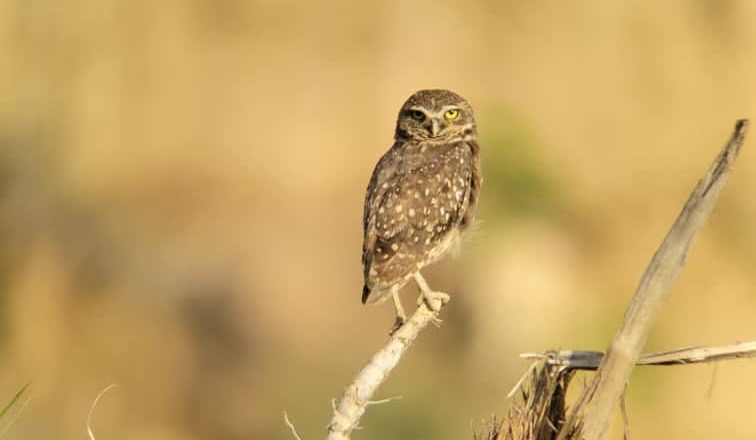After trekking for four days through the Salkantay Pass to Machu Picchu, trading mountain mist for rainforest humidity felt like stepping into another world. My body was ready for rest, but my curiosity had other plans. So, I set off for a different kind of adventure, one that promised not ruins or relics, but unfiltered nature.
My partner and I traveled deep into the Peruvian Amazon with Rainforest Expeditions, one of Go Eat Give’s partners in Peru, to the Tambopata Research Center, one of three eco-lodges they operate. It’s not just any lodge; it’s pristine, remote, and nestled deep in the Tambopata National Reserve, hours from the nearest town, where my nightly entertainment (normally a true crime podcast or murder mystery book) was replaced by the sound of howler monkeys and macaws.

Planes, Buses and Boats to The Amazon
The trip began with a short flight from Cusco to Puerto Maldonado, followed by a one-hour bus through the forest. Along the way, a short film played on board, introducing Rainforest Expeditions’ conservation, ecotourism, and community collaboration work. It was a good reminder that travel here isn’t just about what you take away, it’s about what you give back
After reaching the port, we had a 2.5-hour boat ride down the Tambopata River. It was here that the adventure truly began. Our guide, Dino, greeted us at the doc. We quickly came to learn that this man was a walking encyclopedia of the jungle and easily one of the kindest humans we’ve ever met.
Within minutes, the forest started showing off, flocks of birds overhead, a capybara sunbathing by the riverbank, and caimans blending effortlessly into the shallows. The journey didn’t feel like transportation; it felt like initiation.

Arriving in the Peruvian Amazon
After the most peaceful boat ride of my life (I even managed a quick nap and didn’t experience my usual bout of motion sickness), stepping onto the dock felt like entering another world. We were greeted with cool towels and fresh juice before being given a tour of the research center – wooden walkways elevated above the forest floor, open-air spaces that blur the line between indoors and out.
Our room was a dream: a spacious open-air bungalow complete with an outdoor shower, jacuzzi tub, and a private balcony overlooking the forest. No windows. No screens. Just a wooden barrier separates us from the jungle. It was luxury and wilderness in perfect harmony.

Creepy Crawly Night Walk in The Amazon
After a delicious dinner made with locally sourced ingredients, we kicked off our first official activity: a night walk. Dino kindly handed us extra flashlights, as we were underprepared, thinking our phone flashlights would be enough, and led us into the dense forest (thank goodness for Dino).
What we found was a thriving nocturnal world, grasshoppers, bugs disguised as sticks (I believe the official name is in fact Walkingsticks), colorful beetles, and more tarantulas than I ever thought I’d encounter in a lifetime (at least eight). Then came the real surprise: a brilliantly colored snake, which Dino explained was one of the most venomous in South America. His excitement matched our adrenaline and fear. “I haven’t seen one of these in months!” he said.
We ended the night with hot tea back at the lodge, the forest still humming outside our room. With an early 4 a.m. wake-up ahead, we called it a night.

Sunrise with Macaws
Before sunrise, we boarded a small boat to visit one of Rainforest Expeditions’ most iconic sites, the Macaw Clay Lick. As the first light stretched across the river, we arrived and set up Dino’s telescope, waiting quietly as hundreds of scarlet, blue, and green macaws descended on the clay banks, creating a kaleidoscope of color and sound. Dino explained that the clay’s minerals help the macaws neutralize toxins in their diet —a ritual they repeat every morning —and today we got to experience it with them.
After capturing a few (in my opinion) National Geographic–worthy shots, we enjoyed breakfast right there on the riverbank as the macaws continued their show. By 7 a.m., we had already witnessed something unforgettable.

Howlers on a Hike
Later that morning, we returned to the lodge and set out on a daytime hike through the surrounding forest. We finally spotted the howler monkeys we’d been hearing since arrival, red, curious, and entirely unbothered by our presence while we stood there in awe.
We ended our walk by climbing the canopy tower, a structure rising above the treetops with panoramic views of the rainforest. From above, the forest stretched endlessly, dense, alive, and buzzing with life. A pair of macaws (lifelong mates —how cute) perched nearby with their baby, unknowingly putting on a show for us.
Post Dinner Porcupine
That evening, over another freshly cooked meal, Dino invited us for one final night walk. This time, in addition to the usual bugs from the evening before, we spotted a porcupine, a rare sighting even for him. His fascination was contagious, reminding me that curiosity doesn’t fade, even when the rainforest is your office.
After the walk, we had our nightly tea (and some wine) and got ready for our final night sleeping in the rainforest, making sure to take advantage of all our amenities. Did I mention the wildlife may also follow you into your room? Remember, it’s their home, not yours, so be grateful they are willing to share it with you.

Echos of the Jungle
As we packed the next morning, I found myself wishing for just one more morning of jungle sounds. Rainforest Expeditions’ commitment to conservation is everywhere you look, from the solar-powered operations to their partnerships with local communities and researchers. Every guest visit helps fund scientific studies and protect endangered habitats.
Their sustainability work goes far beyond tourism. Through initiatives like native regenerative planting and eco-education programs, they actively restore ecosystems and invest in the future of the Amazon.
For travelers, that means you’re not just a visitor, you’re contributing to something bigger than yourself.
After one final boat ride back to Puerto Maldonado, the staff arranged a taxi town so we could grab lunch before our flight. A small but thoughtful gesture that summed up the entire experience: personal, intentional, and full of care.

Travel with a heart
In just two short nights, the Tambopata Research Center reinvigorated my passion for travel that gives back. It wasn’t just a trip; it was a chance to reconnect with the world, learn, and support the people working tirelessly to protect it. It was a good reminder that adventure and sustainability don’t exist at odds and can, in fact, elevate one another.
If you’re heading to Peru, make sure the Amazon and the Tambopata Research Center are on your list. Go for the wildlife, stay for the one-of-a-kind experience, and leave knowing your visit had a real impact.
~ By Sara Seper on behalf of Go Eat Give and Rainforest Expeditions.